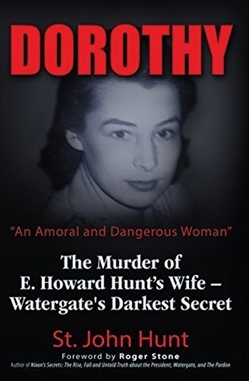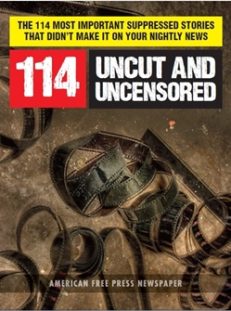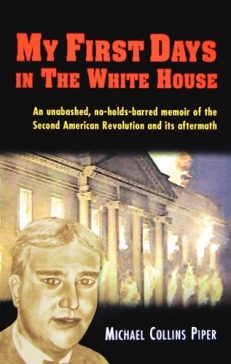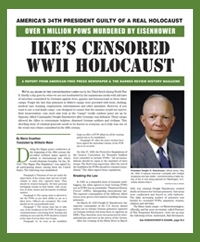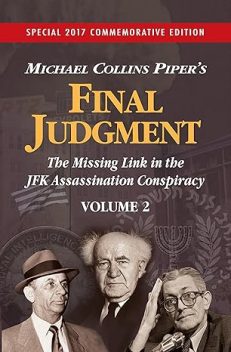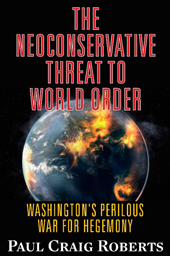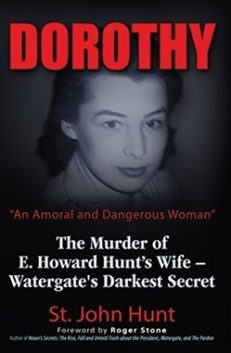CHAPTER 1
Born in Ohio
Born on April Fools Day in 1920 in a small Midwestern town, Dorothy Louise Wetzel would live quite an interesting life. As a child growing up in Dayton Ohio she had no way of knowing that she would one day become a threat to the most powerful man in the world; the President of the United States of America, Richard Milhous Nixon.
Dorothy’s parents were Albert Charles Wetzel (1891-1954) and Jeannette Adams (1891-1961). Dorothy’s paternal grandparents were Anthony Joseph Wetzel (1867-1912) and Mary Therese Kochendorfer (1870-1952). Dorothy’s maternal grandparents were Ella E. Chambers (1865-1940) and Benjamin F Adams (1865-1940), a dentist.
Following some time spent in Pittsburgh, Pennsylvania, the Wetzel family traveled to Ohio and settled along the Miami River. At the time Ohio was one of the farthest lands settled in the West and had been populated by a variety of Indian tribes. The American colonization of Ohio didn’t start until after the Revolutionary War and at various times prior, the area was under French control. During the Civil War, Ohio was on the Union side and was deeply anti slavery. The wave of German immigrants started in the mid-1800’s and continued for many years. Many of Ohio’s wealthiest citizens were German/American and founded such giants of businesses as Goodyear Rubber, Procter and Gamble, and Macy’s.
Dorothy always maintained that she had American Indian blood, and that there was a connection with a tribe of Oglala Sioux and Crazy Horse. It was something, she said that was rarely discussed when she was growing up and it still remains unclear. What was Dorothy’s true family lineage? Was she really part Sioux? She told me she was, and showed me a pair of very old and worn moccasins, which she claimed came from Black Shawl, Crazy Horse’s second wife.
I still have those beautifully beaded moccasins and I remember the day when I was 12 and Dorothy gave them to me along with a book about Crazy Horse written by Mary Sandoz called Crazy Horse, Strange Man of the Oglalas. On the inner flap of the book cover she signed it to me with these words “to my little Indian, Saint John.”
When I was 14 she and I fashioned a Sioux ceremonial shirt for me. She hand stitched it out of heavy muslin, and we both decorated it with horse hair fringe, beaded strips down both arms, and rabbit fur strips hanging down the back. She called it my warrior shirt. I still have it and remember well how she was so proud when I put it on for the first time. She encouraged my interest in all things Indian. We taught each other to speak a few phrases in Sioux. Tashunka Witko, she taught me, means Crazy Horse.
Growing up in Dayton she followed most examples of ladylike behavior. She was rambunctious at times but was never a “bad” girl. She was sent to the principal’s office and disciplined for arguing with a teacher once. She always rooted for the underdog. She never spoke, as many of her peers did, using racial slurs and had no prejudices towards anyone; Jews, Indians, Blacks or whatever.
When Dorothy was 10 her mother Jeanette divorced Albert and moved to San Francisco California. A 1930 census bureau file shows Jeanette and Dorothy Wetzel living in an apartment in the heart of downtown San Francisco. It shows that they lived in #17 on Valencia street and that Jeanette was a cashier at San Francisco General Hospital. They may have moved back to Dayton at some point although my records search has produced little information on this period. Photographs have emerged showing Dorothy in Ohio in 1935 when she was 15. She may have spent a few years in San Francisco and then moved back to Ohio by 1935.
By the time Dorothy reached high school age, she showed an interest in world affairs that set her apart from most of the other girls in her class. They were looking for a way in, into marriage, into children, into middle class security. Dorothy was looking for a way out, out of a dull life, out of wherever she was, and out into the world. It may very well be that the move to San Francisco at such an impressionable age and then back to small town Ohio, was the catalyst that set her on her path of seeking adventure, intrigue and danger.
Dorothy wasn’t yet 16 when she first started developing the features which would come to define her physical looks. Her dark brown almost black hair came to a perfect widows peak above the largest most beautiful almond shaped eyes. Her nose was perfectly shaped with a hint of nobility and exotically high cheek bones that gave a hint of her Sioux Indian heritage. She was an only child and by all accounts a well mannered introspective child until she realized that the world was bigger than her town, bigger than her state and she wanted to be a part of it. The wide eyed beauty of Dorothy was becoming apparent and the world was calling. Dorothy would answer that call.
I have photographs of Dorothy in Indian Lake, Ohio 1936, which at the very least shows that she was back in Ohio five years after the census showed that Jeanette and Dorthy lived in San Francisco. Dorothy would have been 15 when she and her mother moved back to Ohio. What happened then is completely unknown to me. In Tad Szulc’s 1974 book Compulsive Spy, he states on page 64 that from the age of three she lived with her uncle and aunt because her parents had divorced and heer mother evidently could not afford to take care of a young child.
It goes on to say that Dorothy went to a Cleveland high school and attended Bowling Green University in Bowling Green Ohio. In this brief description of her Szulc says that she was an avid reader and spoke fluent French and Spanish by the time she joined the CIA. The CIA?
In another photograph I found of Dorothy sitting, a radiant beauty, with what appears to be a cocktail at her table. Her corsage tells me that it could be a college soirée although the people in the background don’t appear to be nearly as glamorous. There is much mystery surrounding Dorothy Wetzel and what details are available to those willing to search, were written by people that never knew her. There are many parts to a person’s life, and even though she was my Mother, there are many things about her that I will never know. If she were drinking a cocktail, she may have been twenty one.
It is more than evident that between 1935 when Dorothy was 15, and 1941 when I believe the picture was taken, she transformed herself from a gangly midwestern girl into a self assured woman ready to take on the world. Her look was exotic to say the least. I do know that she attended college in Ohio, and by 1945 she was a woman with a ferocious sense of purpose. That sense of purpose included travel and with the War going in full swing, she joined the Treasury Department, Hidden Assets Division. Dorothy’s first posting was to Bern, Switzerland.
CHAPTER 2
Bern, 1944
In 1944 Bern was the center for Intelligence gathering for the Office of Strategic Service, the wartime predecessor of the CIA.
Switzerland was neutral during World War II and as such made it the buffer for countries wanting to do business with Nazis. By 1944 when Dorothy was stationed in Bern, it was clear that the war was coming to an end.
As Allied troops made their way to Berlin, the amount of gold looted from countries that had fallen to Hitler’s war machine was at an all time high with over 440 million dollars in gold bullion pouring into Swiss bank accounts. The ovens and wholesale slaughter at the death camps were working 24 hours a day and as much as 316 million dollars had been taken directly from the death camps in the form of pocket watches, jewelry, and gold teeth.
With a seemingly endless supply of victims the death camps had become a huge source of wealth for the Nazis. These items were confiscated from the prisoners and then melted down at the Reichsbank in Berlin and turned into gold bars, which were then deposited into protected accounts from which the Nazi war machine would use to buy supplies. It is my speculation, since we know that Dorothy was stationed in Bern and worked for the Treasury Department’s Hidden Assets, that she was more than likely to have been involved in Operation Safe Haven.
In addition there have been some writers and publications that have stated that Dorothy was in fact CIA although in 1944 the CIA hadn’t yet been created and would not be until 1947 the OSS did have a strong presence in Bern, and Dorothy may have worked for them at that time. At the very least it is well documented that Bern, Switzerland with it’s proximity to Germany was a hub of international intrigue with OSS and British MI-6 agents recruiting people with access to embassy sources and even those from our own State and Treasury Departments to act as spies and double agents.
Operation Safe Haven was a joint undertaking by the State Department and the Treasury Department to track down and block the flow of Nazi assets in neutral and nonbelligerent counties throughout Europe and the Americas. The fear was that German political and economic leaders, sensing defeat, would act to transfer huge blocs of industrial and fiscal capital to neutral countries thereby escaping confiscation and reparations by Allied forces. By extension it was feared that if Nazi assets were not found and held, it was very likely that Germany would rebuild and start a Fourth Reich within 20 years. WW III? It was a real fear.
In any event, the overriding goal of Safe Haven was to prevent Germany from ever starting another war. The immediate goals were to restrict German economic penetration outside the borders of the Reich, to stop Germany from hiding assets in neutral countries, to make sure that German assets would be available for post war reparations and the rebuilding of Europe, and finally to prevent the escape of the Nazi ruling elite who had been marked as war criminals. In August and September of 1944, instructions were sent out to various State and Treasury Departments to implement these objectives.
Almost immediately there waged a bureaucratic battle between State and Treasury as to how best to follow the directives. This fight for control of Safe Haven ultimately led to its next and most important phase: centralize intelligence and data collecting under one power. It was to this end that the OSS was formally invited to oversee Safe Haven. Dorothy’s participation in Safe Haven would have been under the umbrella of the OSS, and her duties would be subject to OSS directives.
Within the OSS, Safe Haven fell under the control of the Secret Intelligence (SI) Branch which was responsible for gathering intelligence from clandestine sources inside neutral and German occupied Europe. Safe Haven became part of the OSS SI branch, and by default another branch of OSS, the counter-intelligence or X-2 division. From this point on, Safe Haven was a joint operation of the SI and X-2 branches of OSS. It was a perfect merger, away from bureaucratic infighting between State and Treasury, towards clandestine secret operations placed under a wartime spy apparatus Office of Strategic Service. Dorothy was moving up and deeper into the world of covert intelligence: spying. I don’t think we’re in Kansas anymore.
In 1945 Bern, the Chief of OSS was Allen Dulles. Dulles was to become the Director of Central Intelligence (CIA) in 1953-1962. It is safe to say that Safe Haven was one of the many operations under the watchful eye of Dulles. There have been many articles and books written about Allen Dulles, some of them showing his patriotism and others showing his favoritism for his “old boy” network of contacts in the Swiss banking elite. It has been shown that Dulles may have steered intelligence investigations away from some of his cronies who may have otherwise been prosecuted under Safe Haven guidelines.
As this book is not an examination of Dulles’ character, or of his innumerable merits as an intelligence master, I will refrain from further discussion of such a fascinating topic. My interest in Dulles is merely to weave a traceable storyline concerning Dorothy’s ever deepening involvement in the world of covert intelligence. There is no doubt in my mind that Dulles would have crossed paths with one of his most beautiful assets.
While in Bern , Dorothy’s work continued in the search for hidden Nazi assets, until a most unusual cable was received by her office shifting manpower and resources in an entirely new direction. In 1946 the State Department received a secret report from a Treasury agent named Emerson Bigelow that a highly reliable source had information that in 1945 the Vatican (yes, the Vatican), had confiscated 350 million Swiss francs in Nazi gold for “safe keeping.” The gold had been kept in secret numbered Vatican accounts in Swiss banks and then moved to Vatican City banks owned by the Vatican.
It was additionally stated that a large percentage of this Vatican gold had been obtained at the death camps. The document finally declassified in 1996 and released in 1997 was called the Bigelow Report. There is no doubt that the OSS and specifically the office where Dorothy worked was the source for this top secret report and sent it over to the State Department.
As a Catholic, Dorothy must have been horrified and disgusted at the notion of the Vatican, so Holy, thieving gold from thieves. The Vatican to this day denies any knowledge of the accusations made in the Bigelow report. Dorothy however, was not persuaded.
In 1946 it was a city of intrigue, glamor, and danger. Dorothy was happy in Bern and had settled into a comfortable lifestyle, working at Herrengasse during the day, and going to parties at the many embassies and private Chateaus in and around Bern at night. Nightlife in Bern was exciting, seductive and magical and Dorothy had no shortage of suitors. SShe learned how to ski and on weekends she would take to the ski slopes with friends and ski away the day, falling in the snow and laughing like a little school girl but always ready to give it another try.
The evenings would usually end with bottles of wine, or cocktails around a warm fire and the soft whispers of some anxious diplomat wanting to taste this strangely exotic American girl. Dorothy was somewhat of a Mata Hari. A tool for spies.
Spying has always relied on the talents of its most beautiful women, and Dorothy understood her part in this cat and mouse game. The game was to make the mouse think he was the cat when all the time it was Dorothy who had the sharpest claws. She was no mouse. She was ferocious. This game of sexual manipulation could be at times dangerous but always thrilling.
The danger came from many areas. How intoxicated could she get her “target” and still obtain useful information from him? What would she do under circumstances whose only avenue was allowing a sexual conquest? Would she surrender? Was her target a spy trying to elicit information from her? Was he a killer? Was she being recorded or filmed? This was not an uncommon tool used to manipulate agents on either side into becoming double agents or moles. She obtained her .25 cal semi automatic pistol while she was in Bern and told me she kept it within reach during these midnight trysts.
All over America women were doing everything they could in support of the Allies. Here in Bern she was doing her part as well. The difference in her mind was that she was closer to the danger, closer to the excitement … it was, she would say to me many years later, intoxicating. This would have been quite a major adjustment to most girls from Ohio, but Dorothy was drawn to it. She was driven by it and this was just the beginning. She felt, like most spies I suppose, a sense that what they were doing was belonging to a world that transcended normal boundaries of morality and legality.
But years later, it would be these exact notions that would bring about the downfall of her life and the office of the President. But for now, the feeling she had about these early years, she would say, was that it was part of her induction in this secretive and glamorous world. In the course of her duties at Herrengasse she had met the man in charge of all things: Allen Dulles.
She told me he seemed to be a strict man with a kind face. Although they rarely spoke, and then only in passing, she knew he was destined to be a great man. She had no way of knowing just how much of a role Dulles would play in her life.
In early 1946 she heard that Treasury was opening a new foreign office. They were looking for employees with an eye towards adventure. That was Dorothy. She put in her request and in the fall was notified that she had been accepted for inclusion into the new foreign office in Shanghai, China. China, the Great Wall, and forbidden cities. She was thrilled about her move to China. Dorothy phoned her mother Jeanette and told her of this marvelous opportunity! Having known her mother whom I affectionately called “Gaga,” I know how she would have felt about her daughter’s insatiable desire for travel.
(Continues…)


